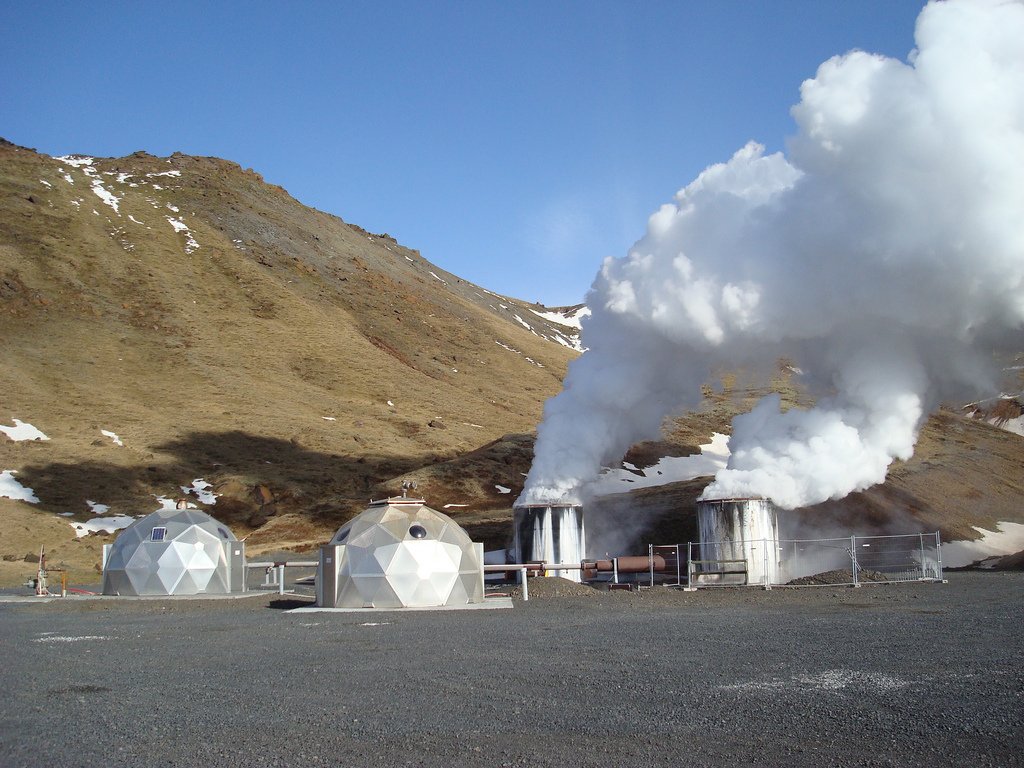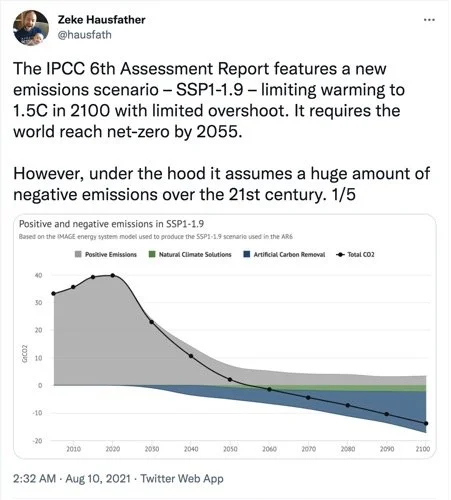
The most optimistic of climate change scenarios are becoming more plausible
One of the most debated parts of the recently released 6th assessment report of the intergovernmental panel on climate change, or IPCC, is also its brightest glimmer of hope. It would require the advancement of new technologies that are scraping carbon from the atmosphere. Zeke Hausfather, quoted throughout the article, is a contributing author to the IPCC report and helps us untangle the science behind negative emissions.
Oct.26, 2021
The broad set of innovative solutions known as carbon removals, or negative emissions technologies, could place humanity squarely on a path traced by climate scientists, gathered under the banner of the IPCC, to keep the planet under 1.5°C of warming. This temperature threshold is the stated objective of the Paris Agreement, an international treaty on climate change signed by the quasi-totality of the world’s governments and which will form the basis for the discussions to take place in Glasgow over the next couple of weeks during the COP 26, an annual conference bringing together heads of states and a small army of negotiators to discuss the best way to avoid the worst of global warming.
While many question the plausibility of the IPCC scenario attached to the Paris Agreement goal - referred to in their latest report as SSP1-1.9 and one of five such narratives, a wave of new technological developments in negative emissions technologies could make our odds of staying under 1.5°C a lot better. From novel forms of concrete embedding carbon into their make-up, to large scale direct air capture plants coupled with tech using sea water to trap CO2 in geological formations, and the revival of ancestral technics such as biochar, there’s a lot of good news out there if you are rooting for carbon removals.
Yet in the first instalment of the IPCC’s 6th assessment report, which was released over the summer, the effects of these solutions on global warming only exist “under the hood” of the best-case scenario foreseen by the world’s leading climate scientists. In what is the report’s rosiest model, out of the five being proposed, the carbon budget we have if we want to limit warming to 1.5°C is 500 billion tons of CO2. In other words, 500 Gigatons of CO2 is how much carbon dioxide we can still afford to emit while staying on the Paris Agreement’s track. In this same scenario, the total of humanity’s emissions would reach 700 Gigaton of CO2 over the 21st century, blowing way past our 500 Gigaton carbon budget. But the model’s underlying data deploys 430 Gigaton of negative CO2 emissions, bringing us back in the safe climatic zone. That it resorts to negative emissions to balance its models is something the IPCC report does not clearly state, but has now widely been reported on. It can easily be inferred by exploring the data sets used by IPCC scientists, which are open for public use.
Source of the graph: Breakthrough Institute.
That the document does not explain in detail how negative emissions would support some of its projections, is partly due to the fact that the question will be addressed in a later IPCC report. What will be the third in a series of four instalments will be published in March next year, and will cover the mitigation of climate change. “The Working Group one report released this summer does not discuss emissions associated with mitigation scenarios per se” tells us Dr. Zeke Hausfather, a contributing author to the report hailing from Berkley Univeristy. “However, it uses a new mitigation scenario that limits warming to below 1.5°C by 2100, that is produced using the IMAGE model and is available in the SSP database.”
Hausfather, who is also director for climate and energy at the Breakthrough Institute, a California-based research centre, is an expert in the data supporting climate models. This has convinced him that negative emissions need all the support they can get. “There is a variety of 1.9 scenarios in the literature beside the marker scenario selected for use by the 6th assessment report of the IPCC. About half use more negative emissions, and about half use less. None of the 1.9 scenarios have no negative emissions and those that limit them tend to have even more stringent near-term emissions reductions that may prove challenging given the current lack of demonstrated political will,” he says.
A reason why engineering solutions are seldom mentioned by climate scientist in public debates might be linked to the dissensions surrounding the topic. The focus on large machinery, potentially to be deployed at a very large scale if we want to use its full impact on climate change, is not without controversy. Climate activists are traditionally sceptical of ‘technological fixes’, attempts at solving climate through engineered means. After all, isn’t technological development to blame for the climate’s current state? Many would rather believe that trees, not machines, could be our main source of climate-saving negative emissions.
“None of the 1.9 scenarios have no negative emissions and those that limit them tend to have even more stringent near-term emissions reductions that may prove challenging given the current lack of demonstrated political will.”
In fact, all ways of removing carbon from the atmosphere, including trees, have their limitations, which need to be balanced. These range from the impact of land usage on food prices, to the eventually limited availability of the waste biomass or freshwater that is essential to the workings of some of the means we have of removing carbon dioxide from the atmosphere. Another important factor is each solution’s ability to store the gas for more than a few decades. This is why trees and crops, generally considered to trap carbon for shorter periods of time, only represent a small fraction of the carbon to be removed until 2100 under the IPCC’s SSP1-1.9 scenario. The remainder and biggest fraction of carbon removals should come from a set of technology-based solutions: direct air capture, biochar, bioenergy with carbon capture (BIOCCS), and enhanced weathering on land or coasts.
One criticism of carbon removals is simply that they are not available yet. Although data on the current total amount of carbon removal per year is not being collected in any kind of systematic way, some estimates place it around 4,000 tons per year. A direct air capture facility recently launched in Iceland, Orca doubles that figure, and although that still keeps us far off from the potential of removing several billion tons of CO2 from the air under the SSP1-1.9 scenario, the prospect it opens in terms of tons of carbon removed seems “reasonable” according to Hausfather.
This is counting with the fact that humanity’s arsenal of carbon removal techniques includes a variety of other innovative solutions, and also that even more direct air capture plants could be built in just the next few years. If Orca is, for now, the biggest facility of its kind, Climeworks, its owner, plans to scale its carbon dioxide removal capacity by a factor of 80 in the next 3-4 years, aided by larger versions of the plant – ‘Mammoth’ is name of the next such installation being planned. Other organisations, also members of Negative Emissions Platform, are already touting plans to soon build several direct air capture facilities able to remove and store underground some 1 million tons of CO2 annually. Estimates for biochar or BioCCS are equally promising. All these new solutions are in fact on track to eventually pull several Gigatons - billions of tons - of CO2 out of the atmosphere every year, as foreseen in the scenarios of the IPCC’s climate researchers and scientists.
This lack of appropriate support in Europe is partly compensated by the fact that the nascent industry is now backed by a budding ‘carbon market’.
Linked to the argument of technological maturity is the one of the technology’s expensiveness, and eventually of its scalability. At current costs, building enough direct air capture plants to have a significant impact on climate change would be prohibitively expensive. This probably is the now the single biggest challenge that some carbon removal technologies, notably direct air capture, now have to solve.
Direct air capture’s high cost is tied to its reliance on large amounts of renewable energy to power its installations, and especially to separate the CO2 from the sorbent used to bind it before it is stored away underground. It is, in other words, a cost that cannot easily be brought down, as it depends on the technology’s physical dynamics. This is why achieving it’s full potential will require considerable investments, going beyond the type of funding that is expected by in-lab research and other prototyping projects. This is something that the EU Commission for example has yet to include in the funding options it has laid out for carbon removal technologies. Other negative emission technologies, while scaling up, will come to head with similar issues.
This lack of appropriate support in Europe is partly compensated by the fact that the nascent industry is now backed by a budding market for high-quality removals. This includes customer partnerships with the likes of Microsoft, Shopify or Stripe, which buy carbon removal credits from Climeworks and other similar companies to compensate for the portion of their own carbon footprint which they cannot, in spite of their efforts, easily reduce: employee commutes, emissions from their own buildings, those of their supply chain, which they cannot directly control, and so on. The upcoming EU Carbon Removal Certification Framework - intended to facilitate the purchase of carbon removal credits by both private and public buyers - will play a key role in making high-quality removals commercially viable.
Hellisheiði geothermal power plant, Copyright ON Power - Photo by Arni Saeberg.
National authorities could also eventually help back such markets and, under the rules of the Paris Agreement, launch a global mechanism for carbon exchange between countries. It is often considered that the creation of a such an instrument could be the biggest achievement for COP negotiators, as they prepare for discussing it in the coming days. The question of how private and public market will interact and how to avoid ‘double counting’ will be at the heart of the debates in Glasgow.
Some countries however, are already moving forward. The Swiss government has announced that it hopes to collaborate with its Icelandic counterpart in order to further build on projects similar to Orca. It has signalled that it aims to better understand if part of its stated climate goals under the Paris Agreement can be achieved by supporting CO2 storage in Iceland via a Swiss-Icelandic partnership for CO2 capture and storage. Because the subsoil of Switzerland, unlike the Icelandic basalt, is not adapted to the storage of carbon dioxide, the Swiss approach is to evaluate investment in Iceland which would lead for it to receive carbon market credits. As a result of this, it could, for example, compensate for emissions from its own citizens’ air travel. A major source of emissions that will be very hard to eliminate in the near future.
There is little doubt that all of these developments in carbon markets will encourage the constructions of new negative emissions plants and installations, and will also contribute to making carbon removal less expensive. It is useful again to observe the case of direct air capture, as the technology is the paragon of a climate solution deemed too expensive to deploy. In a chicken and egg kind of way, although it is costly to build more Orca-like plants, it will also probably be the best way to drive their price down. A study published in May this year by Lackner and Azarabadi, both from the Arizona State University, estimates that the direct-air-capture industry will need to grow by a factor of a little more than 300 in order to achieve costs that will make it commercially viable. However, the calculations are based on facilities far smaller and shorter lived than Orca.
An analogy often used by proponents of carbon removal technologies is that it is quite possible that the price of removing a ton of carbon will soon experience a similar curve to that of solar energy in past decades, and at a much faster rate. Solar technology is indeed now in some places cheaper than any other energy source. For carbon removal start-ups, becoming cost competitive is just the beginning of the journey, and current costs might soon be remembered as nothing but a small bleep in the history of their technologies’ deployment, in the same way that few remember the prohibitive price of personal computers only a few decades ago. But for that to be true, and based on the IPCC’s most hopeful projections, we will need to start building many carbon removal installations, not in 10 years, but now. “If we want to limit warming to 1.5C we will almost certainly need large-scale net-negative emissions later in the 21st century, which means that we need to start developing and deploying the technologies to cost-effectively capture CO2 at scale today”, says Dr. Hausfather. The speed at which this takes place, depends not just on cost curves calculations, but on our collective dedication to make the best-case scenario for climate happen.


